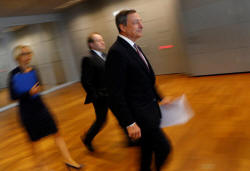|
ECB keeps door open to
even more stimulus
 Send a link to a friend
Send a link to a friend
 [September 07, 2017]
By Balazs Koranyi and Francesco Canepa [September 07, 2017]
By Balazs Koranyi and Francesco Canepa
FRANKFURT (Reuters) - The European Central
Bank reaffirmed its ultra-easy policy stance on Thursday, even keeping
the door open to increasing bond purchases, dashing hopes it would
formally signal its intent to claw back stimulus from next year.
The ECB kept rates at their record lows, confirmed that asset buys would
continue at 60 billion euros ($71.76 billion) per month at least until
December and said it could even increase or expand the asset purchases
if needed, sticking with its long-held super easy stance.
The statement is likely to rattle some investors who expected the ECB to
start laying the groundwork for a cut in monetary stimulus because
growth is robust, the threat of deflation long gone and unemployment
falling fast -- all supporting the case for removing at least some of
the bank's extraordinary measures.
Investor attention now turns to ECB President Mario Draghi's 1230 GMT
news conference, during which he may still offer at least some clues to
the evolution of the bank's view on stimulus and will also detail new
economic projections.

"If the outlook becomes less favorable Governing Council stands ready to
increase the program in terms of size and/or duration," the ECB said in
a statement.
The euro <EUR=> remained roughly 0.5 percent higher against the dollar
after the ECB's decision.
The key dilemma for Draghi in deciding whether to continue or wind down
the asset purchases is that while growth is robust, inflation will
remain under the ECB's target of almost 2 percent for years to come
given a sizable slack in the labor market and the absence of meaningful
wage growth.
Designed to cut borrowing costs, boost demand and raise inflation, the
ECB's 2.3 trillion asset purchase scheme has run for 2-1/2 years,
successfully countering the threat of deflation but boosting consumer
prices by less than it had hoped.
Though the ECB has preferred to tailor its message by the smallest of
increments, time is running out for a decision as the scheme is due to
end in December, requiring a decision at the Oct. 26 or Dec. 14 rate
meetings.
[to top of second column] |

European Central Bank (ECB) President Mario Draghi arrives for a
news conference about the ECB's governing council's interest rate
decision in Frankfurt, Germany, September 7, 2017. REUTERS/Kai
Pfaffenbach

Hawkish rate setters led by Germany argue that the scheme has reached its
potential so it should be wound down. But "doves" say that a rapid exit could
tighten financial conditions too much, undoing the program's successes.
Part of the caution may be related to the euro's <EUR=> 13 percent gain against
the dollar this year.
While the rally in great part reflects the euro zone's solid economic run, it
exacerbates the ECB's inflation problem by putting a natural lid on import costs
and consumer prices.
The ECB is expected to lift its growth projections on Thursday but cut the
inflation outlook, indicating that price growth will miss its target at least
through 2019 after already falling short for more than four years.
Analysts polled by Reuters predicted no policy change on Thursday and expect
bond buys to be cut by one-third in a decision later this year.
At the news conference, the main question is whether Draghi will signal a policy
shift that is now essentially expected by all investors. He is also certain to
face questions about the firming euro.
Draghi is seen as certain to ask the ECB's committees to prepare policy options
for the coming meetings, a signal that has in the past preceded actions.
But policymakers' hands are increasingly tied as the asset buys are slowly
running up against the ECB's self-imposed rules.
Abandoning the rules would be legally difficult while including new assets in
the scheme would risk sending the wrong signal, some economists argue.
($1 = 0.8361 euros)
(Editing by Catherine Evans)
[© 2017 Thomson Reuters. All rights
reserved.] Copyright 2017 Reuters. All rights reserved. This material may not be published,
broadcast, rewritten or redistributed. |